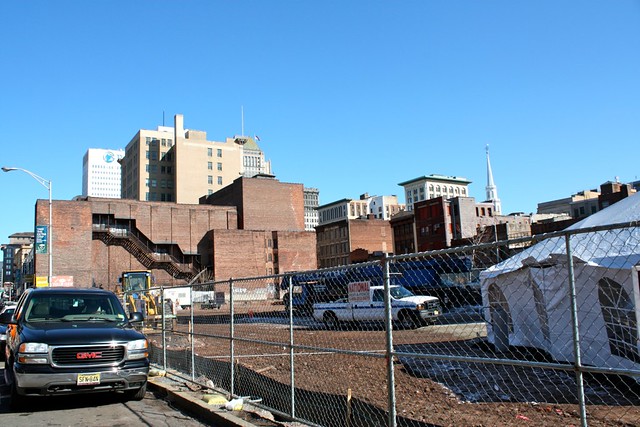Future site of the Teachers’ Village development in downtown Newark, New Jersey
Yesterday Newark Mayor Cory Booker, New Jersey Governor Chris Christie, and several private developers and investors—including Goldman Sachs CEO Lloyd Blankfein—converged on a vacant lot in Newark’s historic downtown for the groundbreaking of Teachers’ Village.
The mixed-use development, a project six years in the making, will include expanded space for three existing public charter schools and a private pre-school; 200 moderately priced apartments reserved for Newark public, charter, and private school educators; and space for retail establishments, including restaurants and possibly a supermarket. The project’s designer is the Newark-born architect Richard Meier, best known for the Getty Center in Los Angeles and, locally, the all-glass luxury condominium building at 1 Grand Army Plaza in Brooklyn.
The $150 million, eight-building project was largely publically financed, with support from federal, state and city governments. Its progress is evidence of Booker and Christie’s continuing cooperation, across party lines, on a school reform agenda focused on the expansion of the charter school sector. New Jersey civil rights organizations and teachers’ unions have criticized the state’s charter schools for serving a lower proportion of special-needs and English-language learner students than traditional public schools, and have cautioned against the risk of neighborhood schools turning into warehouses for the least-advantaged children. Politically, the Teachers’ Village concept could help Booker and Christie neutralize such critics by placing school reform in the broader context of urban revitalization supported by education advocates from across the ideological spectrum.
The project’s lead developer, RBH Group president Ron Beit, said clustering housing for teachers from charter, public and private schools would encourage “socializing and the exchange of ideas.… It’s like an artists’ enclave or a technology cluster for businesses, but here it’s for teachers.” Rents have been calculated to fit teachers’ budgets, at about $700 for a studio apartment, $1,100 for a one-bedroom, and $1,400 for a two-bedroom.
Popular
"swipe left below to view more authors"Swipe →
While those prices may seem like a bargain just twelve miles from New York City, they are actually typical for downtown Newark, which still has many abandoned buildings and few retail options serving middle-class consumers. Teachers are attractive tenants compared to the neighborhood’s current, mostly low-income residents; they are educated and middle-class, and a survey of Newark teachers conducted by RBH Group found enthusiasm for housing options with shorter commute times and proximity to restaurants, movie theaters, bars, museums and shopping. If developers can lure hundreds of teachers to downtown Newark, there’s reason to believe higher-quality retail options—and with them higher rents and bigger profit margins—will follow.
But given central Newark’s continued struggle to revive, are teachers ready to move to the neighborhood? The RBH Group survey found that currently, just 19 percent of Newark teachers live in the city proper; 29 percent live in the New Jersey suburbs; 19 percent live in New York City; and 10 percent live in Jersey City. As in many American cities, the uneven quality of Newark’s public schools may be keeping teachers from enrolling their own children in the district. The best way to convince Newark teachers and other middle-class professionals to live in the city might be to focus less on building teacher-specific housing and more on overall school improvement efforts across the city, in both charter and traditional public schools.
Newark is not the first city to experiment with workforce housing for teachers, and to combine such projects with a standards-and-accountability school reform agenda. Baltimore’s Miller Court includes forty teacher apartments, 70 percent of which are rented by Teach for America recruits. In Los Angeles, the Glassell Park complex combines a district pre-school with affordable housing for teachers and other community members.
Another model is an attempt to increase parents’ involvement with their children’s education by co-locating schools with housing reserved for low-income families. Using a mix of public and philanthropic dollars, the Brooklyn Kindergarten Society runs four full-service children’s centers within public housing projects in the neighborhoods of Crown Heights, Bed-Stuy and Brownsville. The centers include pre-schools and family support services, and the Society partners with city social service agencies to identify which children living in public housing are most in-need of early academic enrichment.
Of course, this type of project lacks the potential profit-making upsides of market-rate housing for middle-class teachers.



